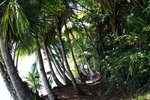
The dodo bird (Raphus cucullatus) gets its name from one of two possible sources. The more likely of the two is the Dutch word “dodoor,” which means “sluggard” and relates to Dutch sailors’ descriptions of the bird as lazy and slow. It’s also possible the name derived from the Portuguese word “doudo,” used to describe something that is foolish or simple. While this reputation for being slow and stupid is widely credited as the reason for the bird’s demise, the truth is humans hunted dodos to extinction. The last living dodo was seen prior to 1681.
Physical Appearance
Dodos were described as large plump birds with wings at their sides too small or weak to lift the bird off the ground. Archaeologists believe the bird was around 5 feet long and weighed about 40 pounds when full grown. They had gray feathers on their bodies and tails with white plumes, and short, thick legs ending in 4-toed feet with black claws. Dodos are perhaps most well-known for their large hooked beaks, which were either pale yellow or green in color.
Range and Habitat
The dodo bird only ever lived on Mauritius, a small island in the Indian Ocean about 500 miles from the island of Madagascar. Prior to 1598, no humans lived on the island. These flightless birds lived in forests throughout the island. They nested in grassy parts of the forest, where females laid and incubated one egg at a time.
Behavior
The only accounts of the dodo bird’s behavior come from Portuguese and Dutch sailors and Dutch settlers. According to these reports, the birds waded into shallow water to catch and eat fish. People were most fascinated with the birds’ apparently frequent habit of eating stones, which modern scientists believe may have aided digestion. They are generally described as being clumsy, stupid and slow. Aside from their powerful beaks, dodos had no defense against predators. If they made any sound at all, historical reports describe a goose-like call typically heard from nesting sites.
History
Prior to human incursion on Mauritius, the dodo had no natural predators. As a result, when Dutch settlers first arrived on the island, dodos were curious and not at all afraid of them. Humans routinely killed dodos for food. Those that weren’t hunted were killed by cats, dogs and other invasive non-native species that came along on the boats with the people. These animals invaded the woods, trampling dodos’ nests and eating their eggs and young. The Dutch began a colony on the island in 1644, and in less than 40 years’ time the dodo bird had been wiped off the face of the Earth.
References
Photo Credits
-
Photos.com/Photos.com/Getty Images
Writer Bio
Jennifer Mueller began writing and editing professionally in 1995, when she became sports editor of her university's newspaper while also writing a bi-monthly general interest column for an independent tourist publication. Mueller holds a Bachelor of Arts in political science from the University of North Carolina at Asheville and a Juris Doctor from Indiana University Maurer School of Law.




